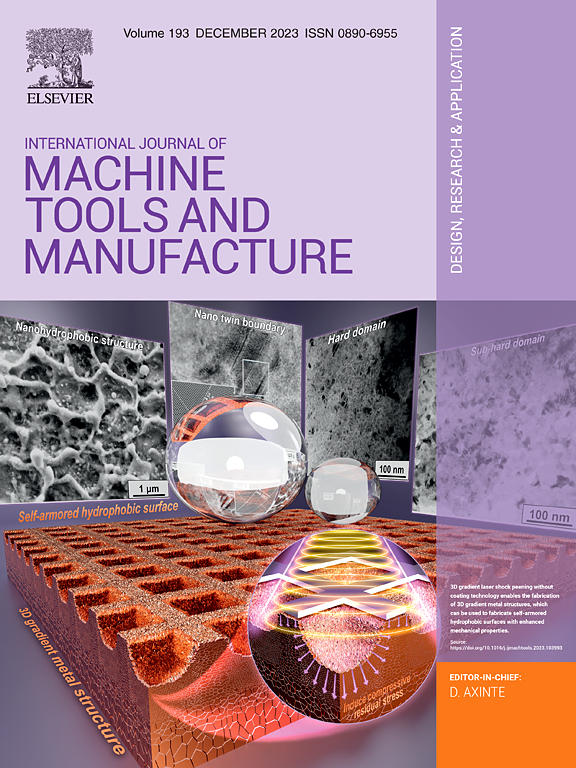Stable tongues induced by milling tool runout
IF 18.8
1区 工程技术
Q1 ENGINEERING, MANUFACTURING
International Journal of Machine Tools & Manufacture
Pub Date : 2025-03-01
DOI:10.1016/j.ijmachtools.2025.104258
引用次数: 0
Abstract
High material removal rates and performances are required for modern milling operations, which may trigger self-excited chatter vibrations. Such undesired vibrations cause unacceptable machined surface quality and premature deterioration of the cutting tool. After many decades of research and successful industrial solutions to this problem, some unexpected phenomena still arise, which put in doubt the effectiveness of well-known chatter theories and of the associated predictive numerical methods. Specifically, runout is a typically ignored consequence of inaccurate fixing of the tool, which has essential impact on the actual cutter-workpiece engagement and on the machined surface quality. The unequal engagement of cutter teeth change the dynamical behavior radically and prevent the application of classical simplifications in the modeling of milling processes. Moreover, in addition to the kinematically different teeth cycle-paths, the coexisting forced vibrations induce early fly-over effects of cutting edges creating new stability boundaries close to the resonant oscillations. This paper presents the underlying principles of this experienced phenomenon related to tool runout and its stabilization effect on chatter vibrations. Focusing on conventional milling cutters, the paper breaks with the widely held assumption that forced vibration has negligible effect on stability in the presence of tool runout. Initial laboratory experiments validate this tool irregularity induced phenomenon and industrial tests demonstrate the technical relevance of the results.

铣刀跳动引起的舌头稳定
现代铣削作业需要高的材料去除率和性能,这可能会引发自激颤振。这种不希望的振动导致不可接受的加工表面质量和刀具的过早劣化。经过几十年的研究和成功的工业解决方案,仍然出现了一些意想不到的现象,这使人们对众所周知的颤振理论和相关的预测数值方法的有效性产生了怀疑。具体来说,跳动通常是刀具不准确固定的一个被忽视的后果,它对实际刀具-工件啮合和加工表面质量有重要影响。刀具齿的不均匀啮合从根本上改变了动力学行为,阻碍了经典简化在铣削过程建模中的应用。此外,除了运动上不同的齿周路径外,共存的强迫振动还会引起切削刃的早期飞越效应,从而在共振振荡附近产生新的稳定性边界。本文介绍了这种与刀具跳动有关的经验现象的基本原理及其对颤振的稳定作用。本文以传统铣刀为研究对象,打破了人们普遍认为的在刀具跳动时强迫振动对稳定性的影响可以忽略不计的假设。初步的实验室实验验证了这种工具不均匀现象,工业测试证明了结果的技术相关性。
本文章由计算机程序翻译,如有差异,请以英文原文为准。
求助全文
约1分钟内获得全文
求助全文
来源期刊
CiteScore
25.70
自引率
10.00%
发文量
66
审稿时长
18 days
期刊介绍:
The International Journal of Machine Tools and Manufacture is dedicated to advancing scientific comprehension of the fundamental mechanics involved in processes and machines utilized in the manufacturing of engineering components. While the primary focus is on metals, the journal also explores applications in composites, ceramics, and other structural or functional materials. The coverage includes a diverse range of topics:
- Essential mechanics of processes involving material removal, accretion, and deformation, encompassing solid, semi-solid, or particulate forms.
- Significant scientific advancements in existing or new processes and machines.
- In-depth characterization of workpiece materials (structure/surfaces) through advanced techniques (e.g., SEM, EDS, TEM, EBSD, AES, Raman spectroscopy) to unveil new phenomenological aspects governing manufacturing processes.
- Tool design, utilization, and comprehensive studies of failure mechanisms.
- Innovative concepts of machine tools, fixtures, and tool holders supported by modeling and demonstrations relevant to manufacturing processes within the journal's scope.
- Novel scientific contributions exploring interactions between the machine tool, control system, software design, and processes.
- Studies elucidating specific mechanisms governing niche processes (e.g., ultra-high precision, nano/atomic level manufacturing with either mechanical or non-mechanical "tools").
- Innovative approaches, underpinned by thorough scientific analysis, addressing emerging or breakthrough processes (e.g., bio-inspired manufacturing) and/or applications (e.g., ultra-high precision optics).

 求助内容:
求助内容: 应助结果提醒方式:
应助结果提醒方式:


